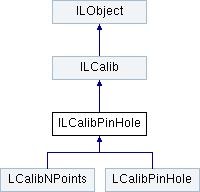This interface provide functionalities of the pinhole camera model. More...

Public Member Functions | |
| LPVErrorCode | AddMVPoints (ILCalibPointPairs *pointPairs) |
| void | SetCameraProps (double cellSize, double focusLength, double viewDistance) |
 Public Member Functions inherited from ILCalib Public Member Functions inherited from ILCalib | |
| LPVErrorCode | AddPoint (double imagePointX, double imagePointY, double worldPointX, double worldPointY) |
| LPVErrorCode | AddPoints (ILCalibPointPairs *pointPairs) |
| LPVErrorCode | Calibrate () |
| LPVErrorCode | FixImage (ILImage *image, ILImage *fixedImage) |
| LPVErrorCode | GenPostTransformMatrix (ILCalibPointPairs *pointPairs) |
| void | ImageToWorld (double imagePointX, double imagePointY, double *worldPointX, double *worldPointY) |
| BOOL | IsCalibrated () |
| void | SetImageSize (int w, int h) |
| void | SetPostTransform (double offsetX, double offsetY, double deltaAngle) |
| void | SetPostTransformMatrix (ILTransform *tf) |
| void | SetPostTransformMatrix23 (LMatrix23 *data) |
| void | SetPostTransformMatrix33 (LMatrix33 *data) |
| void | WorldToImage (double worldPointX, double worldPointY, double *imagePointX, double *imagePointY) |
 Public Member Functions inherited from ILObject Public Member Functions inherited from ILObject | |
| ILObject * | Copy () |
| LPVErrorCode | Load (LString filename) |
| void | Reset () |
| LPVErrorCode | Save (LString filename) |
| BOOL | Valid () |
Properties | |
| LPVDistortionModel | DistortionModel [get, set] |
| The distortion model. | |
 Properties inherited from ILCalib Properties inherited from ILCalib | |
| double | CalibError [get] |
| The overall RMS re-projection error for the calibration, calculated based on the distances between the image points and the projected (using the optimized calibration matrices) world points. It's defined as: \( \sqrt{ \frac{1}{n} \sum_{i=0}^{n} distance(p^{image}_i, p^{proj}_i)^2 } \). | |
| LPVFixImageMode | FixImageMode [get, set] |
| The mode to fix image used in FixImage(). More... | |
| double | FixImageOffsetX [get, set] |
| The x-coordinate offset (in pixel unit) of the fixed image used in FixImage(), used together with FixImageOffsetY. By default, it's 0, means no offset in x-coordinate. You may change the offset to translate the fixed image, for example move the inspect region to the center of the fixed image. | |
| double | FixImageOffsetY [get, set] |
| The y-coordinate offset (in pixel unit) of the fixed image used in FixImage(), used together with FixImageOffsetX. By default, it's 0, means no offset in y-coordinate. You may change the offset to translate the fixed image, for example move the inspect region to the center of the fixed image. | |
| double | FixImageScale [get, set] |
| The scale of the fixed image used in FixImage(). By default, it's 1, means no scale. You may change the scale factor to zoom in/out the fixed image. | |
| LPVInterpolationMethod | InterpolationMethod [get, set] |
| The interpolation method used in fix the image for undistortion (and untilt). By default, it's LPVInterCubic. | |
| LPVCalibModel | Model [get] |
| The calibration model. | |
| BOOL | UseCache [get, set] |
| Whether to make use of cache which is used to speed-up the process of the image undistortion (and untilt), but consume more memory. By default, it's off. | |
This interface provide functionalities of the pinhole camera model.
In the pinhole camera model, a scene view is formed by projecting 3D points into the image plane using a perspective transformation, defined as:
\[ s \; m' = K \; [R | t] \; M \]
where \( m' \) are the image points in pixels, \( M \) are the world points in physical units, \( K \) is the intrinsic camera array involves camera's principal point and focus lengths in pixel units, \( [R | t] \) is the extrinsic camera array describes the camera's relative position to the view planar, \( s \) is the scale factor for the whole system.
Intrinsic parameters are independent to the viewed scene while extrinsic parameters do, which means if we move the camera other places without changing the focusing, the intrinsic parameters stay unchanged but extrinsic parameters should be re-calibrated.
This model support radial distortion estimation, see DistortionModel for more details.
The accuracy of the calibration result is affected by many factors:
To use this interface, you should create a LCalibPinHole object.
| LPVErrorCode AddMVPoints | ( | ILCalibPointPairs * | pointPairs | ) |
Add point pairs for multi-view calibration.
| [in] | pointPairs | The collection of point pairs from assistant view. |
| error | Return error code if anything is wrong. |
| void SetCameraProps | ( | double | cellSize, |
| double | focusLength, | ||
| double | viewDistance | ||
| ) |
Set some property of the camera or the viewed scene, which is used in setting up initial value for calibration.
| [in] | cellSize | The cell size of camera sensor(in μm), should be available in datasheet of the camera device. We use same cell size for both x and y coordinate as in most cases they are same. |
| [in] | focusLength | The focus length of camera sensor(in mm), should be available in datasheet of the camera device. |
| [in] | viewDistance | The approximate distance from viewed plane to camera(in mm). |